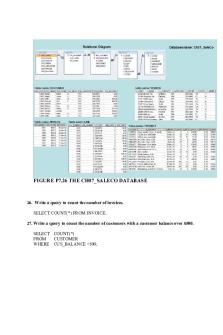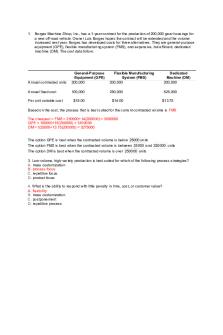Ch-7 Establishing objectives and budgeting for the promotional program PDF

| Title | Ch-7 Establishing objectives and budgeting for the promotional program |
|---|---|
| Author | Omar Gonzalez |
| Course | Marketing Channels |
| Institution | Northeastern Illinois University |
| Pages | 5 |
| File Size | 199.2 KB |
| File Type | |
| Total Downloads | 26 |
| Total Views | 162 |
Summary
Chapter 7 summary. Establishing objectives and budgeting for the promotional program. Advertising and Promotion An integrated marketing communications perspective...
Description
VALUE OF OBJECTIVES Many companies fail to set specific objectives. o Objectives have functions within communications, planning & decision making, & measurement & evaluation. Communications – having clear objectives helps avoid communication problems Planning & Decision Making – facilitates planning and decision making. Measurement & Evaluation – objectives should be measurable – determines how well the program is working and if the investment was worth it.
DETERMINING OBJECTIVES Advertising objectives are NOT the same as Promotional objectives. o Marketing Objectives – what is the goal and time frame of the marketing program. Quantifiable: Time frame to accomplish goal (Typically 1 year) Realistic Attainable Key! – Marketing goals (Increase in sales, profit, or market share) are usually NOT promotional objectives. Marketing goals require promotion but many other things as well. Promotional Objectives could be (Creating interest and/or trial for a product). A company can be successful in promoting a product, creating interest, but product is not available in store or consumer doesn’t buy because its over-priced. o Integrated Marketing Communications Objectives – what various aspects of the IMC program will be accomplished. Should be based on communication tasks required to deliver the right message to the target audience.
SALES VERSUS COMMUNICATIONS OBJECTIVES Sales-Oriented Objectives o CONCERN: Difficult for companies to identify which channels have the highest ROI. o Many managers believe objectives should be based on increasing sales. Problems with Sales Objectives 1. Increase in sales could be due to a combination of things, not just sales-oriented objective.
2.
Carryover Effect – money spent on advertising doesn’t have an immediate effect on sales.
3.
Offers little guidance to those who created the promotional program. Where Sales Objectives Are Appropriate Direct-response advertising – consumer purchases through mail, internet, or calling.
o
Sales response generated by ad. Example: JCPenney having a sale and monitoring store traffic + sales volume compared to non-sale days.
o
When advertising is dominant and other factors are relatively stable. Packaged goods companies, Kellogg’s.
Communication Objectives
o o o o
Many managers believe objectives should be based on communications. Advertisers must provide information and create favorable predispositions toward a brand before purchases can occur. Communication objectives are the criteria used in the DAGMAR approach. Consumers go through 3 stages in purchasing:
1. 2.
Cognitive (Thinking)
Problems with Communications Objectives 1. Difficult to translate a sales goal into a specific communications objective.
Affective (Feeling) 3. Conative (Behavioral) Communications Effects Pyramid
DAGMAR: AN APPROACH TO SETTING OBJECTIVES o o o
Colley Defining Advertising Goals for Measured Advertising Results (DAGMAR) Model for setting advertising objectives and measuring the results of an ad campaign. 4 Stages: 1. Awareness – making consumer aware of product. 2. Comprehension – what the product is and what it will do. 3. Conviction – developed mental disposition in the consumer to buy the product 4. Action – getting consumer to buy the product.
Characteristics of Good Objectives Concrete, Measurable Tasks
Precise message to communicate to the target audience. Well-Defined Target Audience Benchmark and Degree of Change Sought To set objectives one must know target audience’s present status with hierarchy of variables (Awareness, knowledge, image, etc. Determine degree to which consumers must be changed by the campaign.
Assessment of DAGMAR o Communications based rather than sales based. o Hierarchy of effects. o Colley Criticism of DAGMAR 1. Consumers don’t always go through hierarchy effects before buying something. 2. Achieves communication goals but not sales goals. 3. Expensive and time-consuming. 4. Imposes too much structure.
ESTABLISHING AND ALLOCATING THE PROMOTIONAL BUDGET
Establishing a Budget Companies often see communications budget as an expense rather than an investment. o Theoretical Issues in Budget Setting Marginal Analysis Weaknesses. 1. Assumes sales are a direct result of promotional expenditures and this effect can be measured. 2. Advertising is solely responsible for sales. o Almost all advertisers follow one of two models of the advertising/sales function. 1. Concave-downward function. a. As advertising increases, its incremental value decreases. Suggest optimal influence on sales requires fewer advertising dollars. 2. S-Shaped response curve. a. Suggests small advertising budget as well as too much spending will have NO impact on sales. Budget Approaches Top-Down Approaches o Budgets established at executive level. 1. The Affordable Method (AKA: All you can afford) a. Budget can be too low or too high 2. Arbitrary Allocation (What is felt to be necessary) a. NOT a good approach. 3. Percentage of Sales (Based on sale of a product) a. Most common method b. Financially safe + keeps ad spending reasonable. c. Disadvantage is that its solely based on sales. d. Does not allow for changes in strategy. e. Difficult to implement if product is new, no previous data.
4. Competitive Parity (Mimic competitors budget) a. Advantage: stability in the market place 5. ROI a. Ads and promotions considered investments.
Build-Up Approaches 1. Objective and Task Method (3 Steps) a. Defining communication objectives b. Determine specific strategies and tasks c. Estimate the cost...
Similar Free PDFs

CH7 review for final
- 2 Pages

Ch7 - Ch7
- 11 Pages

M1 and d1 copy - Promotional
- 6 Pages

Ch7
- 4 Pages

Promotional Appeals
- 2 Pages

Objectives for FYWP E101
- 1 Pages
Popular Institutions
- Tinajero National High School - Annex
- Politeknik Caltex Riau
- Yokohama City University
- SGT University
- University of Al-Qadisiyah
- Divine Word College of Vigan
- Techniek College Rotterdam
- Universidade de Santiago
- Universiti Teknologi MARA Cawangan Johor Kampus Pasir Gudang
- Poltekkes Kemenkes Yogyakarta
- Baguio City National High School
- Colegio san marcos
- preparatoria uno
- Centro de Bachillerato Tecnológico Industrial y de Servicios No. 107
- Dalian Maritime University
- Quang Trung Secondary School
- Colegio Tecnológico en Informática
- Corporación Regional de Educación Superior
- Grupo CEDVA
- Dar Al Uloom University
- Centro de Estudios Preuniversitarios de la Universidad Nacional de Ingeniería
- 上智大学
- Aakash International School, Nuna Majara
- San Felipe Neri Catholic School
- Kang Chiao International School - New Taipei City
- Misamis Occidental National High School
- Institución Educativa Escuela Normal Juan Ladrilleros
- Kolehiyo ng Pantukan
- Batanes State College
- Instituto Continental
- Sekolah Menengah Kejuruan Kesehatan Kaltara (Tarakan)
- Colegio de La Inmaculada Concepcion - Cebu









